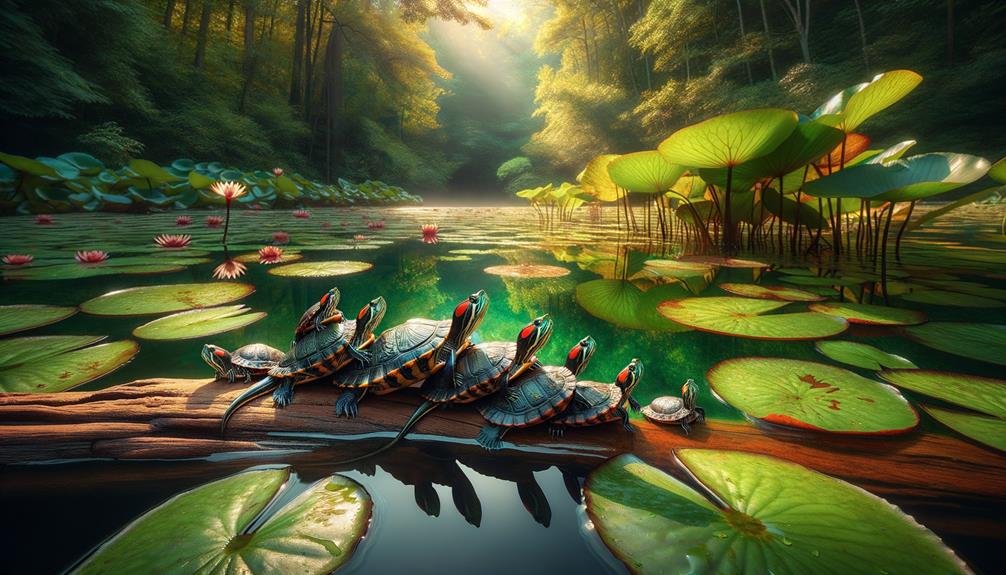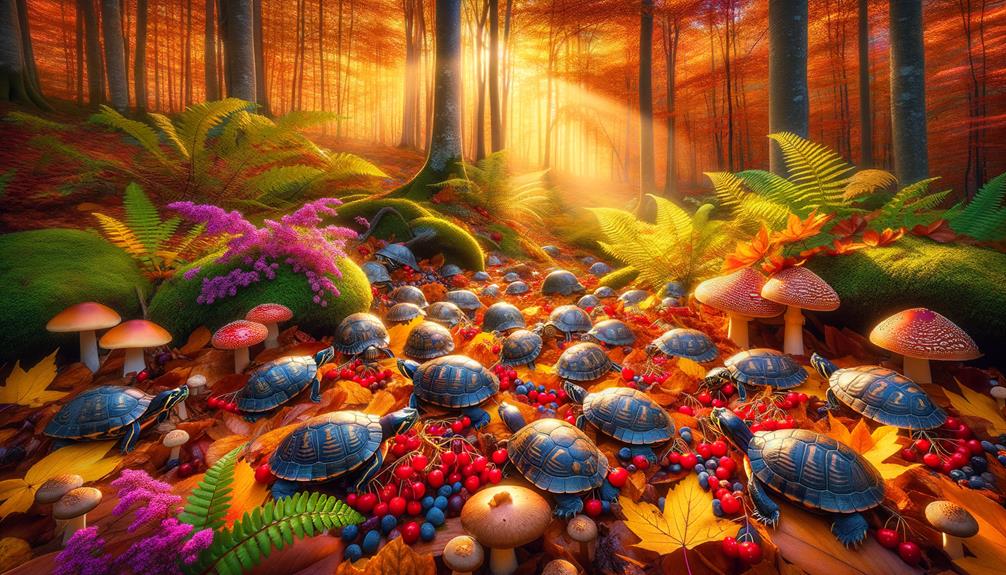Map turtles, with their unique map-like markings, have adapted perfectly to their fast-flowing river and lake habitats in the southeastern U.S. Their flattened, keeled shells provide protection and agility, allowing them to navigate rocky or sandy bottoms with ease. Female map turtles can grow up to 12 inches in length and possess powerful jaws that enable them to crack open mollusks. Their diets undergo distinct shifts, and their reproductive habits are fascinating, often influenced by the temperature of their eggs. Unfortunately, their habitats face constant threats from pollution and human activities. If you’re interested in learning more about their intriguing lifestyle and how to care for them, there’s much to explore.
Key Takeaways
Map turtles have a distinctive shell with yellow or orange markings that resemble topographic maps, helping them blend in with their surroundings. These agile swimmers thrive in fast-flowing rivers and lakes with rocky or sandy bottoms, where their keeled shell structure provides protection and agility. The unique yellow patterns on their shells serve as a natural identification system for different species. To ensure their survival, it’s vital to maintain healthy river ecosystems, as habitat degradation poses significant threats.
Habitat and Distribution
Map turtles thrive in the clear, fast-flowing rivers and lakes across the southeastern United States. I’ve always been fascinated by their adaptability to specific geographic areas, from the Gulf of Mexico to the Great Lakes region. They favor rivers and streams with rocky or sandy bottoms, often featuring submerged logs, branches, and aquatic vegetation. This environment is ideal for basking and foraging, critical activities for their survival.
Their distribution is quite specialized, with 14 recognized species occupying particular types of waterways. Some species prefer larger, more dynamic river systems, while others find their niche in smaller, secluded streams. This adaptability reflects their resilience and unique evolutionary paths.
However, their habitats are under constant threat from human activities. Habitat degradation, water pollution, and encroachment on river systems pose significant risks. The impact of these factors on their natural environments raises concerns about their long-term conservation. Map turtles are not just excellent swimmers and divers; they’re also an integral part of our aquatic ecosystems that deserve our attention and protection.
Physical Characteristics
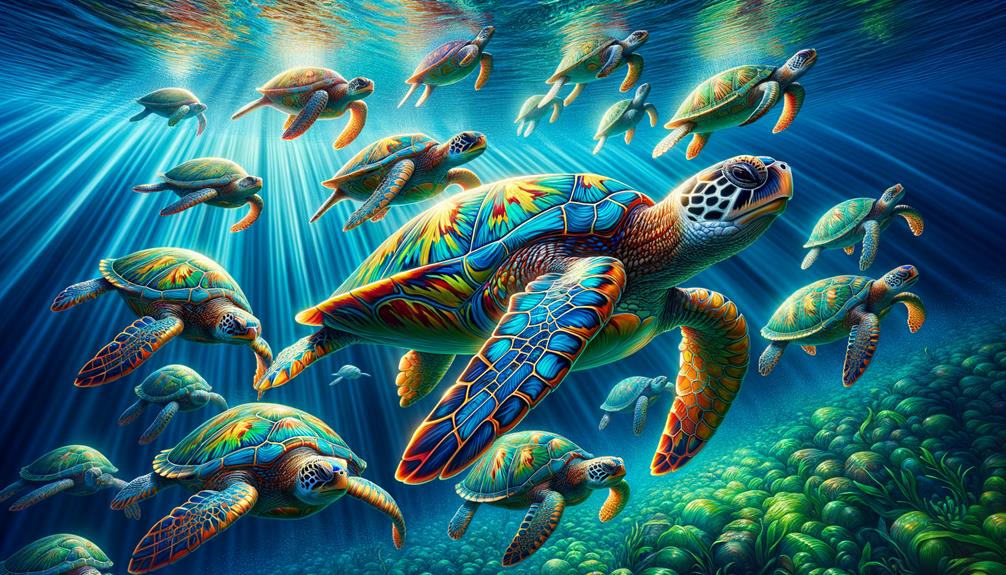
When I first laid eyes on map turtles, their intricate shell patterns immediately caught my attention. Each turtle’s flattened, keeled carapace, adorned with yellow or orange markings, resembles the contours of a topographic map. The noticeable difference between males and females was evident, with the larger females showcasing even more vibrant and diverse coloration.
Shell Shape and Size
Have you ever stopped to admire the intricate design of a turtle’s shell, particularly one that resembles a topographic map? Map turtles, with their distinctive flattened, keeled shells, showcase nature’s incredible craftsmanship. One notable aspect of these turtles is the significant size difference between males and females. Females boast larger shells, reaching up to 12 inches in carapace length, while males typically range from 4 to 6 inches.
The keeled structure of the shell serves a vital purpose. The serrated and keeled edges provide these turtles with enhanced protection and superior agility in their fast-flowing river and stream habitats. This streamlined design makes them agile swimmers and adept divers, allowing them to navigate their aquatic environments with ease.
Interestingly, hatchling map turtles start life with more pronounced keels and serrated shells, features that gradually soften as they mature, particularly in females. This unique adaptation helps them survive the turbulent waters of their early life stages. As they grow, their shells become less exaggerated but retain enough of their distinct shape to aid in their survival and agility.
Unique Color Patterns
The unique yellow patterns on map turtles’ shells are truly mesmerizing, resembling intricate topographic maps. These patterns serve a vital purpose beyond their visual appeal. Each species boasts distinct yellow patterns, making identification a fascinating challenge for enthusiasts and biologists alike.
Young map turtles proudly display their vibrant yellow markings, which provide essential camouflage in their aquatic habitats. As they mature, the intensity of their yellow patterns fades, and the once-vivid designs become more subdued. This subtle shift in coloration aligns with their evolving needs for camouflage and protection.
These intricate patterns also serve as a natural identification system. The specific arrangement and shape of the yellow lines and blotches help distinguish one species from another, alongside other physical traits like shell serration. Whether observing a hatchling or a seasoned adult, the yellow patterns on a map turtle’s shell tell a fascinating story of adaptation, survival, and nature’s artistry.
Dietary Habits
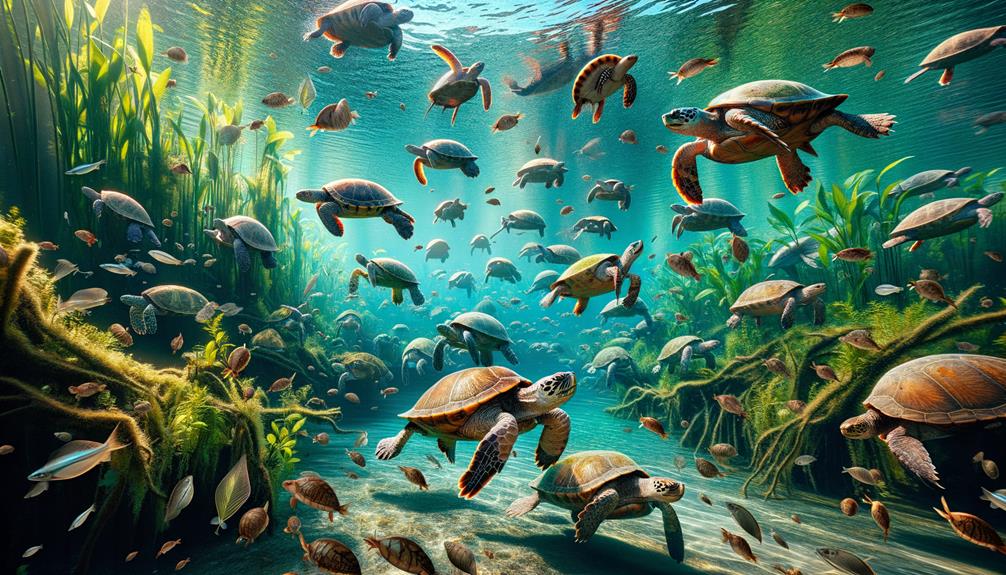
When it comes to their diet, map turtles are fascinating omnivores with a broad range of feeding preferences. I’ve noticed that their dietary habits change with the seasons, which affects their nutritional needs. To maintain their health and growth, captive map turtles require a balanced diet that mirrors the variety they’d find in the wild.
Omnivorous Feeding Preferences
Ever wondered how map turtles thrive in their aquatic environments, feeding on a diverse array of food sources? It’s due to their omnivorous feeding preferences and varied diet. These remarkable turtle species consume everything from crustaceans and mollusks to small fish, insects, and even vegetation. Their ability to adapt to such a wide range of food sources is truly fascinating.
Female map turtles, particularly those from broad-headed species, possess large and strong jaws, enabling them to crack open hard-shelled prey like mollusks and crustaceans with ease. This adaptation guarantees they can access a rich source of nutrients that other species might find challenging to exploit.
Map turtles often hunt near submerged logs, rocks, and other structures that serve as hiding spots for their prey. Hatchlings and juveniles start with a diet rich in plant matter and smaller prey, gradually shifting to larger, harder-shelled targets as they mature.
In captivity, replicating this varied diet is crucial for their well-being. Offering a mix of animal and plant matter ensures these patterned swimmers get the nutrition they need to thrive.
Seasonal Diet Changes
Curious about how map turtles adjust their diets throughout the year? Map turtles are true opportunistic feeders, taking advantage of whatever’s available in their environment. Their diet shifts considerably with the seasons, driven by changes in water temperatures and food availability.
During warmer months, when water temperatures rise, map turtles consume more fish, crustaceans, and insects. These protein-rich options become more abundant, and the turtles capitalize on that. In contrast, during cooler months, their diet leans more toward available aquatic vegetation and occasional fallen fruits. They’re not picky eaters and will even eat carrion or the young of other turtle species if the opportunity arises.
Interestingly, the dietary habits of map turtles also vary with age and sex. Juveniles are more herbivorous, while adults, especially females with their stronger jaws, can easily crush and eat hard-shelled prey like mussels and snails. This adaptability to seasonal diet changes guarantees they get the nutrients they need year-round. So, map turtles are adept at maneuvering the ever-changing menu of their aquatic world.
Nutritional Requirements Overview
Understanding the nutritional requirements of map turtles is crucial for ensuring their health and longevity. These patterned swimmers have a varied carnivorous diet that changes as they age. Hatchlings and juveniles primarily consume more plant matter, while adult males and females focus on hard-shelled aquatic animals.
Adult females, with their stronger jaws, can easily crack open harder-shelled prey like mollusks. In contrast, adult males often prefer smaller fish and invertebrates. Both genders enjoy snails, mussels, crustaceans, and even carrion.
To keep their diet balanced, map turtles benefit from occasional treats like freeze-dried shrimp and krill. Proper calcium and vitamin supplementation is also vital. This ensures healthy shell development and overall well-being.
| Age Group | Primary Diet |
|---|---|
| Hatchlings | Plant matter, small invertebrates |
| Juveniles | Mixed diet, more plant matter |
| Adult Females | Hard-shelled prey, mollusks |
| Adult Males | Small fish, crustaceans |
It’s fascinating to see how these turtles adapt their eating habits as they grow. By understanding their dietary needs and providing necessary supplementation, we can help them thrive in captivity or in the wild.
Reproduction and Lifespan
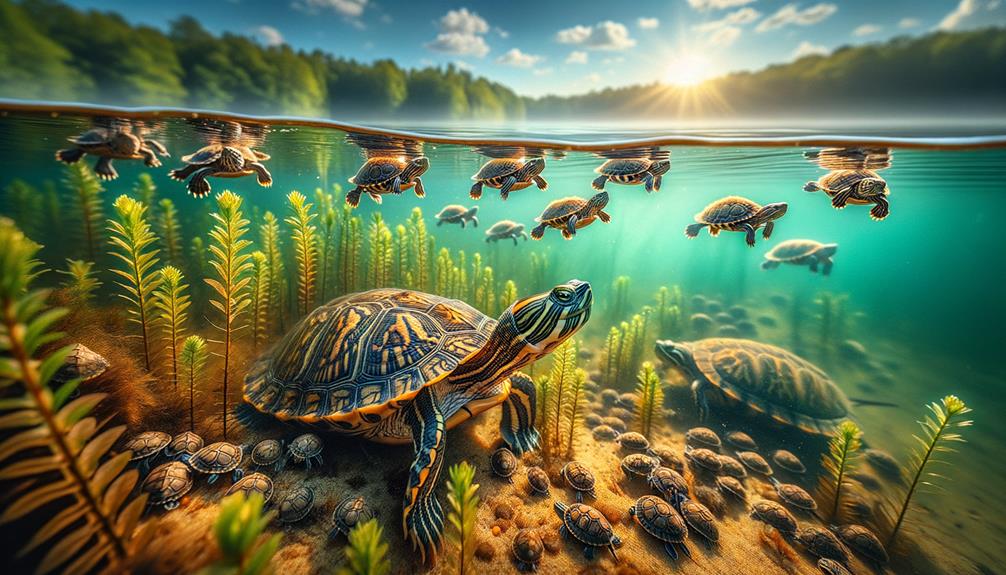
Female map turtles can live up to 40 years or more, while males typically have a shorter lifespan of 20-25 years. This difference in longevity is linked to their physical characteristics, with females generally being larger and more robust. Females take around 10-15 years to reach sexual maturity, while males mature slightly earlier, around 5-10 years.
During the nesting season from May to July, females lay clutches of 5-20 eggs. The 60-90 day incubation period is crucial for the survival and sex determination of the hatchlings. The incubation temperature plays a significant role in determining the sex of the hatchlings, with warmer temperatures producing more females and cooler temperatures resulting in more males.
- Physical characteristics: Larger, more robust females contribute to longer lifespans.
- Nesting females: Lay 5-20 eggs per clutch during May to July.
- Incubation temperature: Warmer temperatures yield more females, cooler temperatures more males.
Map turtles’ reproductive strategy is fascinating, as it helps maintain a balanced sex ratio depending on environmental conditions. Their longevity and unique breeding habits highlight the intricate relationship between physiology and environment, making them an intriguing species to study and admire.
Threats and Conservation
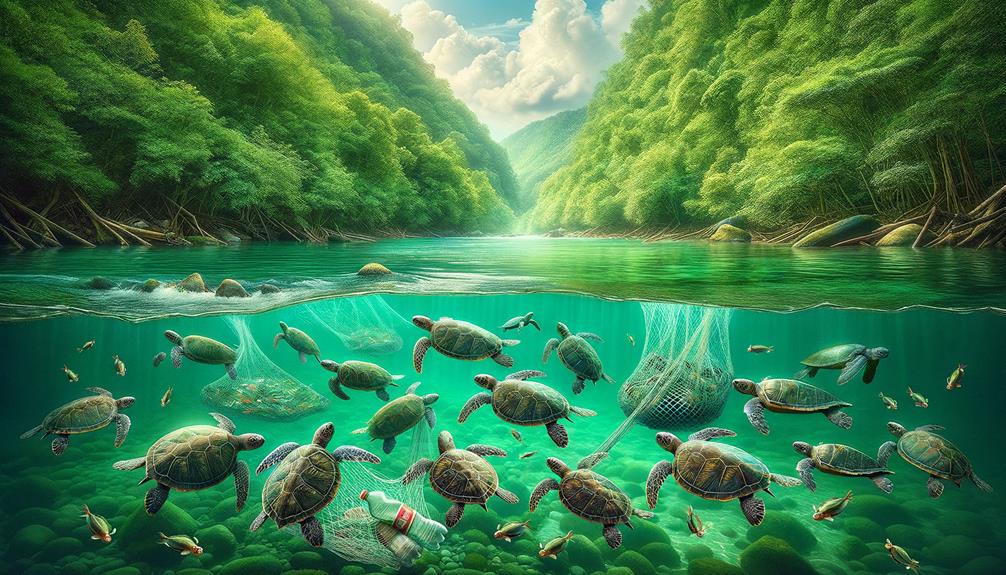
As we marvel at the reproductive strategies and longevity of map turtles, it’s essential to acknowledge the significant threats they face and the conservation efforts needed to protect them. The destruction of their habitats due to shoreline development reduces their nesting areas, leading to increased predation and road mortality risks for nesting females. Water pollution further degrades their habitats, affecting their health and reproductive success.
Invasive species, such as zebra mussels and pond sliders, compete with map turtles for food sources, like mollusks, and degrade their habitat quality. These threats are compounded by commercial collection, which targets several map turtle species, making them even more vulnerable. Some species are so rare and endangered that they’ve been proposed for CITES protection.
To conserve map turtles, we need to maintain healthy river ecosystems with flowing waters, sandy beaches, and abundant mollusk populations. Efforts like captive breeding and reintroduction programs have helped bolster some declining populations, but protecting their natural habitats is crucial. By addressing issues of habitat loss, water pollution, and the impact of invasive species, we can help ensure these patterned swimmers continue to thrive in their native river ecosystems.
Captive Care Essentials
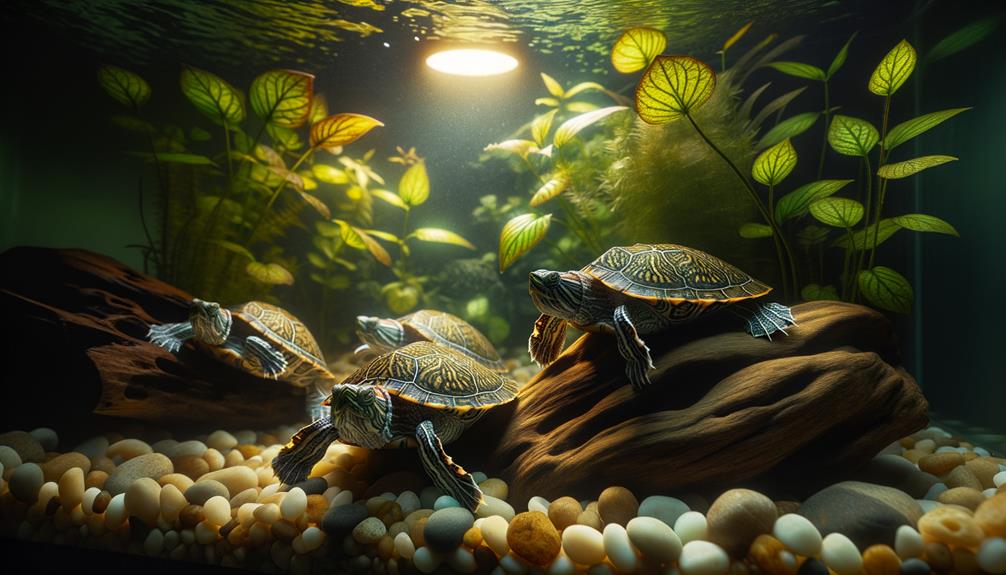
Caring for map turtles in captivity requires a well-planned setup that closely mimics their natural habitat. To start, I ensured the tank size was suitable, providing at least 5-10 gallons of space per inch of their carapace length. Secure furnishings are vital to prevent accidental shifts or upending.
I opted for easily cleaned substrates like sand or river pebbles. Maintaining the right basking temperature is crucial, so I set up heat lamps to keep it between 70-100°F. UVB lighting is vital for vitamin D3 synthesis.
A balanced diet is essential, with commercial pellets forming the bulk of their diet, containing 30-40% protein and less than 20% fat. Providing consistent basking areas prevents skin infections and aids digestion. I also use a titanium water heater to maintain a stable water temperature.
Supplemental foods like worms, crickets, and feeder fish provide a varied diet. Calcium and vitamin supplements are critical for their health. Consistent basking not only supports digestion but also helps with shedding. Without it, they’re prone to skin infections, shell rot, and ear abscesses.
Frequently Asked Questions
Are Map Turtles Good Swimmers?
Map turtles are natural-born swimmers. Their large, webbed feet and streamlined bodies make them agile and quick in the water. They can dive and stay submerged for a long time, navigating turbulent waters with ease and precision.
How to Tell if a Mississippi Map Turtle Is Male or Female?
Identifying a Mississippi map turtle’s gender can be an exciting experience. To do so, I examine the carapace size, head width, and tail length. Female Mississippi map turtles typically have larger carapaces and broader heads, while males have longer, thicker tails.
What Does a False Map Turtle Look Like?
A False Map Turtle boasts a sleek shell adorned with vibrant yellow lines reminiscent of contour maps. Females can grow up to 9 inches in length, while males reach a smaller size of 5 inches. The bright yellow markings on juveniles are particularly striking.
Can I Keep a Map Turtle as a Pet?
You can keep a map turtle as a pet, but be prepared to provide a large aquatic setup, specialized lighting, and a varied diet. They’re not a good choice for beginners, as they require complex care and a significant commitment to their needs.


